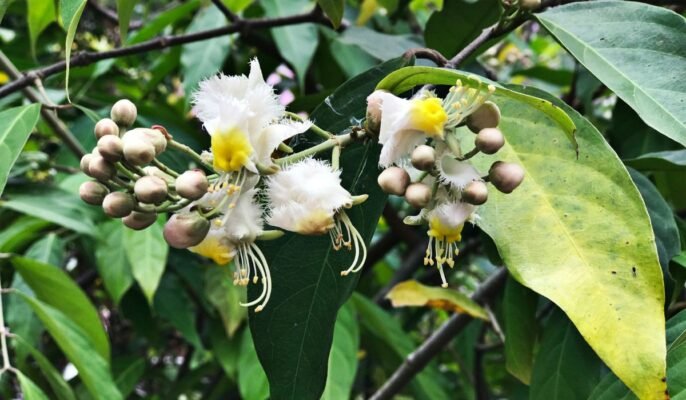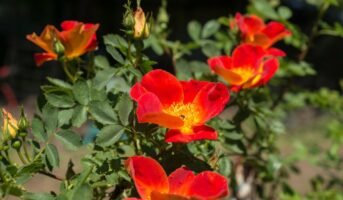Hiptage Benghalensis, commonly known as Madhavi Lata, is a large shrub or high-climbing liana with unusually shaped, strongly perfumed flowers. They range in colour from pink to white, with yellow markings. The corolla has five free, elliptic to round, reflexed petals that are white with one petal yellow in the centre and fringed margins.
Throughout the year, the plant produces flowers in compact axillary racemes. It is also considered a weed in certain regions. The leaves are large and elongated, with pointed tips that sometimes turn a bright red colour when young.
Source: Pinterest
See also: Jade plants benefits and how to take care of themax
Madhavi Lata plant: Key facts
| Scientific Name | Hiptage Benghalensis |
| Common Name | Helicopter Flower, Adirganti, Atimukta, Chandravalli, Haldavel, Kampti, Kamuka, Madhalata, Madhavi Lata, Madhavi, Madhumalati, Madmalati, Ragotpiti, |
| Native | Warm-temperate Asia (South China and Taiwan) and tropical Asia |
| Genus | Hiptage |
| Type | High- climbing liana |
Madhavi Lata plant: Physical description
- The plant has twisting stems and appears woody.
- The stems have multiple small raised whitish spots.
- The leaves are arranged oppositely and are somewhat elongated, measuring 6-20 cm in length and 4-9 cm in width. They have duller and paler undersides.
- The flowers have five white petals, with one being slightly larger than the others and having a bright yellow centre.
- The fruit of the plant has three wings that are 2-6 cm long and turn pale brown when mature.
Madhavi Lata plant: Habitat and distribution
The Hiptage species has been known to naturalise in certain coastal areas of northern and southeastern Queensland, with small infestations found in Brisbane suburbs like Fig Tree Pocket, Toowong, and Moggill, especially near the Brisbane River. It has also been spotted in the Wide Bay pastoral district and near Mossman in northern Queensland. This species can also be found in other parts of the world such as the Mascarenes, Hawaii, and southeastern USA.
Hiptage Benghalensis is commonly found in closed forests and along waterways. It prefers moist and shady habitats but has also been spotted growing in suburban gardens, hedges, and waste areas where it may not have been intentionally planted. Although its distribution is currently limited, it has the potential to become a problematic weed in the wetter tropical, subtropical, and warmer temperate regions of Australia.
Madhavi Lata plant: Cultural and religious significance
- Madhavi lata, a Hiptage plant, is revered in Hinduism and associated with Lord Vishnu. According to the Vishnu Purana, Madhavi (Goddess Lakshmi) is Vishnu/Madhava’s wife, and the plant is named after her. Madhavi Lata represents the creeping vine, and Vishnu represents the tree to which she clings for support.
- When Rishi Kanva discovered that his adopted daughter Sakuntala had met King Dushyanta, the man of her choice, Rishi told her that he had long been looking for a handsome mango tree, obviously referring to Dushyanta and that now he would give his Madhavi lata, i.e., Sakuntala, to him in marriage.
Madhavi Lata: Environmental impact
Hiptage (Hiptage Benghalensis) is a new and potentially serious environmental weed in Queensland.
This extremely invasive environmental weed is currently causing the most concern in northern Queensland’s wet tropics bioregion, where it is thought to pose a real threat to tropical forests and factors that relate to the Wet Tropics World Heritage area. It forms dense thickets over forest vegetation, and the weight of these vines can cause support trees to break and prevent light from reaching the forest understorey.
Madhavi Lata plant: Reproduction and dispersal
This particular species primarily reproduces through the distribution of seeds. Due to the wings on its fruit, they can be easily dispersed over long distances by wind, particularly when released from high up in the forest canopy. Additionally, the fruit might be spread through garden waste that is dumped, or they may float on water.
Madhavi Lata plant: Control
Education and awareness campaigns are effective cultural controls to prevent the weed from being cultivated as an ornamental close to environmentally sensitive areas. It is suggested that bothersome species (including H. benghalensis) be prevented from entering and trying to establish in native ecosystems such as tropical rainforests in nations with tropical regions and pleasant climates.
Weed species should be given high priority for exclusion from entering the country and should be evaluated for eradication as soon as they are discovered. Plant growers must be cognizant of the species’ potential to become invasive in the wild.
See also: Seeds
Madhavi Lata plant: Medicinal uses
- Hiptage is cultivated for medicinal purposes and is well-known in Indian medicine.
- The leaves and bark are acrid, bitter, insecticidal, and useful in treating cough, burning sensation, and inflammation; it is also useful in treating skin diseases, especially dermatitis.
- Scabies benefit greatly from an application made from the plant.
- Its aromatic bark is used in medicine to treat rheumatism and asthma.
Source: Pinterest
FAQs
How do Hiptage seeds spread?
Hiptage Benghalensis is a tendril shrub that is native to Asia. Wind and water disperse its seeds.
What are the characteristics of Madhavi Lata?
A woody climbing shrub with clusters of fragrant pink, white, and yellow flowers and three-winged, helicopter-like fruits. Flowers have an unusual shape and appear to be decorative accessories, with fluffy-toothed edges. The fragrance is strong and pleasant, reminiscent of fruity perfume. The leaves are slender and drooping.
Housing News Desk is the news desk of leading online real estate portal, Housing.com. Housing News Desk focuses on a variety of topics such as real estate laws, taxes, current news, property trends, home loans, rentals, décor, green homes, home improvement, etc. The main objective of the news desk, is to cover the real estate sector from the perspective of providing information that is useful to the end-user.
Facebook: https://www.facebook.com/housing.com/
Twitter: https://twitter.com/Housing
Email: editor@housing.com

